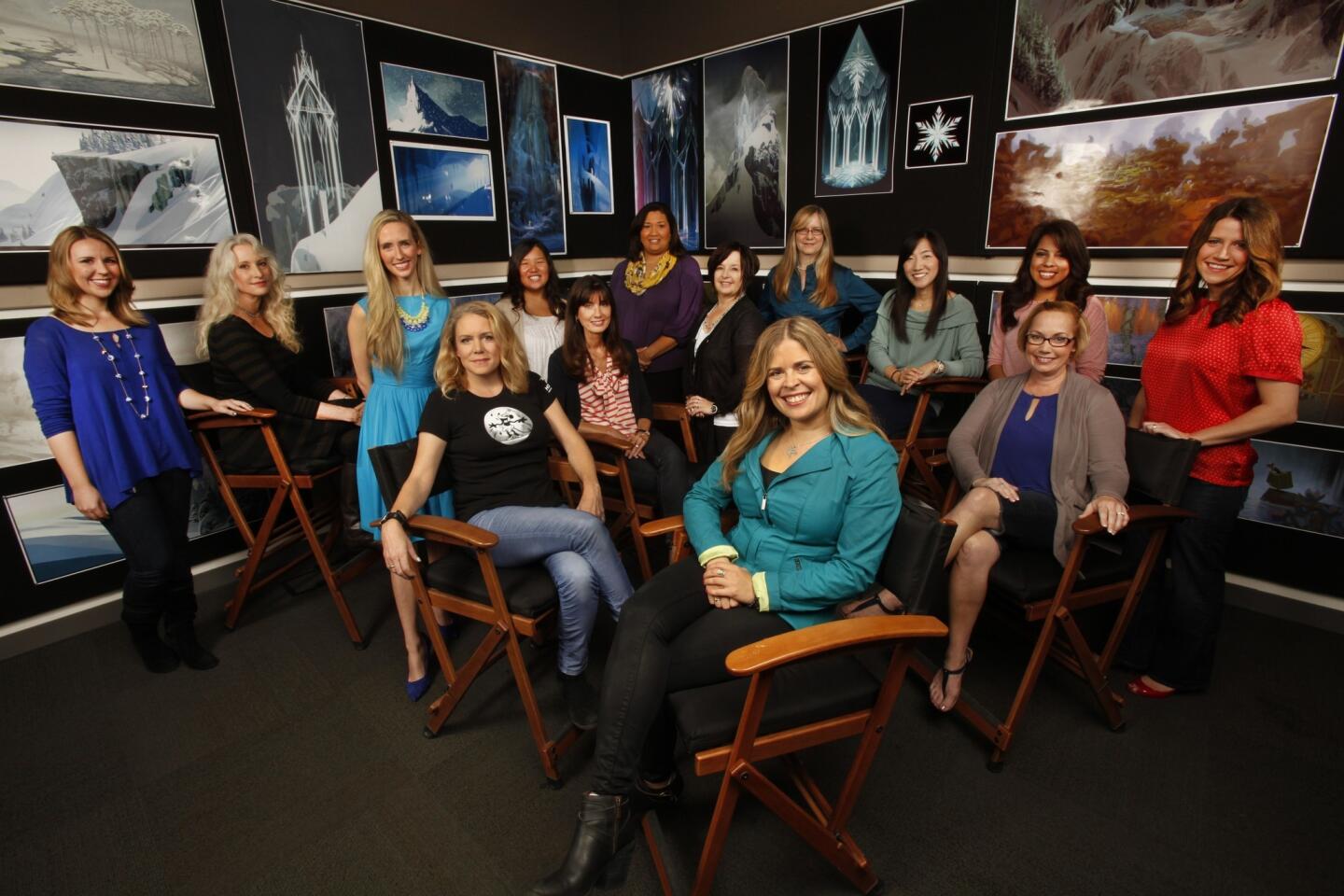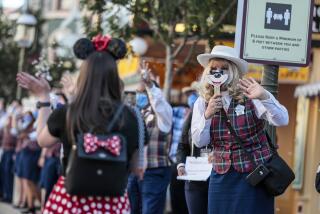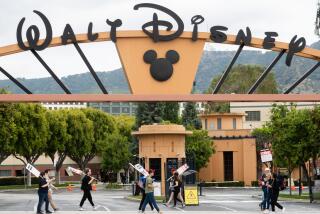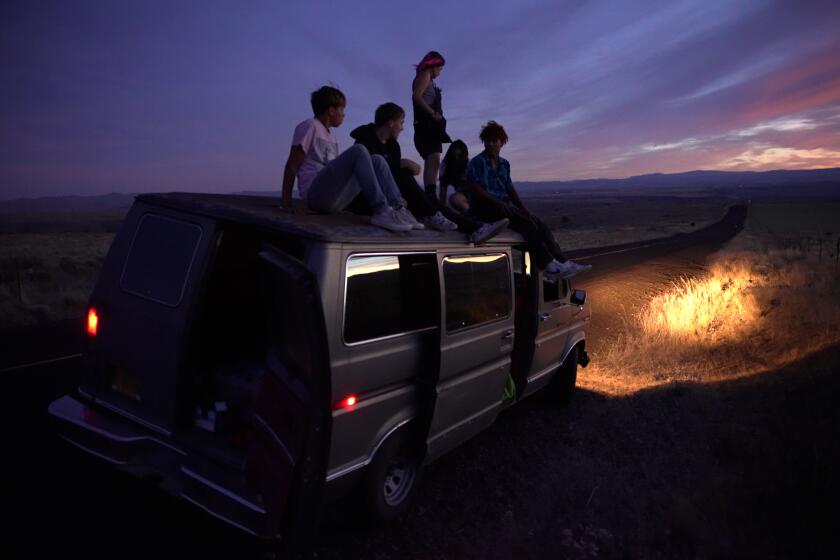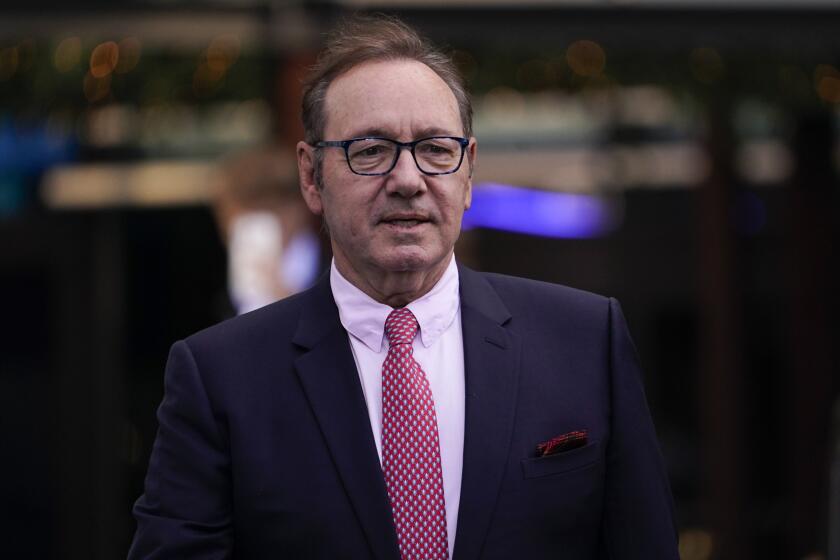‘Frozen,’ ‘Get a Horse!’ female directors mark firsts for Disney
In the 1937 promotional film “How Walt Disney Cartoons Are Made,” an announcer describes some of the intricate work going into the studio’s first feature-length film, “Snow White and the Seven Dwarfs,” in a department called Inking and Painting.
“Here, hundreds of pretty girls in a comfortable building all their own, well-lighted, air-conditioned throughout, cover the drawings with sheets of transparent celluloid,” the announcer says, over images of white-gloved young women preparing male animators’ drawings for the screen. “Then they painstakingly trace every line....”
At Disney in the 1930s — as at just about every other workplace in America at the time — female employees had their place, making the creative work of men look good. (It helped if the women looked good, too.)
PHOTOS: Upcoming Disney fall films and beyond
Three-quarters of a century later, for the first time on a Disney animated feature, a woman’s place is in the director’s chair. Jennifer Lee, a screenwriter, shares directing credit on “Frozen” with animator Chris Buck.
At the same time, the Burbank studio is releasing the short film “Get a Horse!,” a retro-style Mickey Mouse short directed by Lauren MacMullan of “The Simpsons,” marking the first time a woman has had solo directing credit on any Disney Animation movie.
The timing is purely coincidental, according to Disney Animation Chief Creative Officer John Lasseter. But the new era of female creative leadership at the studio is the product of decades of evolution in a slow-moving field popularized by Walt and his “Nine Old Men.”
PHOTOS: Disney’s animated lineup from 1984-1994
“Animation has been a male-dominated industry for a long time,” Lasseter said. “Not that it’s been an old boys’ club. There have been real superstars that were women. But now you’re seeing more women in supervisory and leadership roles, in story, in layout, in animation; in the production side there’s a lot of very strong women. It’s been growing.”
Both Lee and MacMullan seem discomfited by the attention they’re getting for their gender. “Am I really the first woman to do something here by myself?” MacMullan said. “We had to go check because it didn’t really occur to us.” According to Lee, “It wasn’t my top concern in any way.”
The recent boom in animated movies — 11 will get a wide theatrical release this year — has meant more opportunity. But animation isn’t much different from the wider community of Hollywood when it comes to the gender of directors. Women accounted for 9% of the directors on the top 250 domestic-grossing films in 2012, according to the Center for the Study of Women in Television and Film at San Diego State University.
Essential perspective
Recently Lee, MacMullan and 12 other women who worked on “Frozen” and “Get a Horse!” as animators, story artists, visual development artists and production managers gathered in a conference room at Disney to talk about their roles at the company and impact on their films, as well as on Disney’s complicated legacy of female characters.
“These are big animated movies,” MacMullan said. “They cost a lot of money, and what everyone wants for their movie is to hit those four quadrants: You want men, women, little boys, little girls, and the best way to make those movies is with women involved in the making of them.”
A loose retelling of the Hans Christian Andersen fairy tale “The Snow Queen,” “Frozen,” which is due in wide release in theaters Wednesday, centers on the conflict between two royal sisters in a fictional Nordic kingdom: exuberant young Anna (voiced by Kristen Bell) and her remote older sibling Elsa (Idina Menzel).
Early reviews of the film have been positive, with critics noting that “Frozen” manages to avoid the common pitfalls of female-led animated movies that are either hopelessly old-fashioned fairy tales or leaden you-go-girl polemics.
Lee, one of the writers on Disney’s 2012 video game movie “Wreck-It Ralph,” joined Buck, the director of “Tarzan” and “Surf’s Up,” on the film in 2012, four years after the long-gestating project was greenlighted. “Especially because we have two female protagonists, it was great bringing Jen on,” Buck said last spring as the two were still tinkering with their story.
Lee quickly had an impact on the sister story line, which hadn’t been in previous iterations of the film, according to visual development artist Brittney Lee. “As soon as Jen came on, I suddenly saw my sister and I in the sisters,” Brittney Lee said. “I recognized these two are real girls. Once a female perspective was present in the writing, it was so much easier to get behind it.”
Jennifer Lee said she attempted to humanize Anna, who may be the first Disney princess to have gas, and to beef up, quite literally, the male characters. “I kept saying, ‘Can we give Hans thighs, ‘cause that’s kind of appealing?’ They were so little.”
As with “Snow White,” “Cinderella” and the more recent Disney movie “Tangled,” the protagonists of “Frozen” are princesses. Disney’s recurrent princesses are problematic for people who think they propagate a certain standard of slim-waisted, wide-eyed, girlie girlness.
“Frozen” recently entered that debate when Lino DiSalvo, the male head of animation on the film, was quoted on a fan website describing the difficulty of animating female characters because “they have to go through these range of emotions, but you have to keep them pretty.” The comment, which a representative for Disney said was “recklessly taken out of context,” hit a nerve on the blogosphere, for the perceived implication that female characters must, like the “hundreds of pretty girls” in Walt’s old studio, be attractive.
PHOTOS: Celebrities by The Times
Jennifer Lee said the female characters on “Frozen” were challenging to animate not because they’re female, but because they’re the leads, carrying the heaviest burden of expression in the story, while the males are supporting characters with simpler arcs. “Elsa and Anna had to carry subtext, awkwardness, which is hard for animated characters,” she said.
It’s common for animators to film themselves to capture the physics of a character’s movement — on a movie with prominent female characters, it helped to also have prominent female artists.
“Sometimes the male animators would say, ‘I’m trying to do this walk through the hallway and I’m filming myself, and it just looks like a guy,’” said animator Hyun-Min Lee. “I hope we could have helped make those two characters more believable and relatable.”
Redrawing the norms
Disney has a long history of employing female artists, such as Retta Scott, an animator on “Bambi,” and Mary Blair, who drew concept art for “Cinderella,” and created the character designs for Disneyland’s It’s a Small World.
Brenda Chapman, who became the first female director of an animated movie at another studio, DreamWorks, with 1998’s “The Prince of Egypt,” started out as a trainee in the story department at Disney on 1989’s “The Little Mermaid.” At the time, Chapman said, an executive told her she was only hired because she was a token female.
“I didn’t tell anybody because I was so ashamed,” Chapman said in a separate interview. “The guys I worked with were incredibly welcoming. Once in a while someone would say, ‘Hey, did you notice you’re the only woman in the room?’” Chapman would go on to direct “Brave” at Pixar, becoming that studio’s first female director. Lasseter, who also heads that studio, removed her over what he called “creative differences,” but Chapman went on to collect the Oscar for animated feature together with “Brave’s” new director, Mark Andrews.
“I’m rooting for Jennifer from afar,” Chapman said. “At Disney, this is a huge deal.”
PHOTOS: Greatest box office flops
More women are beginning to find the field of animation — when Chapman attended the California Institute of the Arts’ prestigious character animation program in 1987, she was one of five women out of a class of 34. This year there are 98 women enrolled in the same program out of a class of 161, according to the school.
Neither Jennifer Lee nor MacMullan rose through the traditional channels in feature animation, in which a director slowly works his way up from the animation department. Lee studied English at the University of New Hampshire and collected a master’s in fine arts from Columbia University. She has sold multiple original screenplays, but none have yet been produced.
MacMullan worked primarily in television, directing on the animated shows “The Simpsons,” “The Critic” and “King of the Hill.” She brings a tart sense of humor to a studio known for its sometimes cloying sweetness.
Both women came to Disney under the wings of a male director, Rich Moore, and writer, Phil Johnston, whom they credit with setting a friendly tone on “Wreck-It Ralph.” Four of the eight people in the story department on that film were female.
“Once you hit this certain percentage of women in the story room, then everyone feels comfortable talking,” MacMullan said. “You don’t want a story room to be a frat house.”
Women have prominent roles on other planned Disney films; Kristina Reed will produce the studio’s 2014 feature, “Big Hero 6.”
“The one downside of having as many women as we have here is that there’s way too many cupcakes,” said MacMullan.
More to Read
Only good movies
Get the Indie Focus newsletter, Mark Olsen's weekly guide to the world of cinema.
You may occasionally receive promotional content from the Los Angeles Times.
